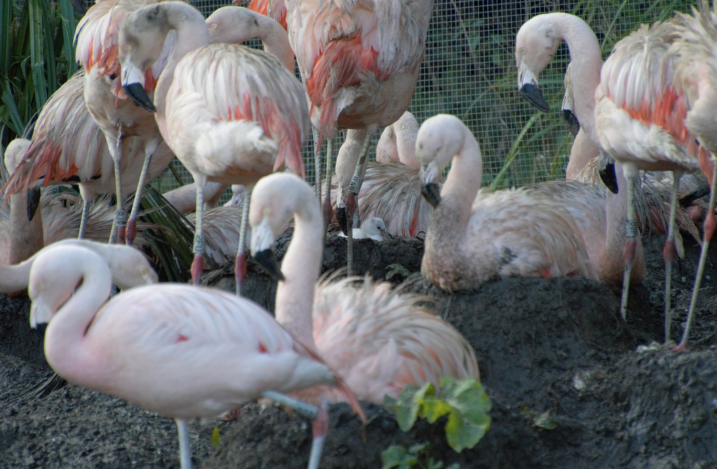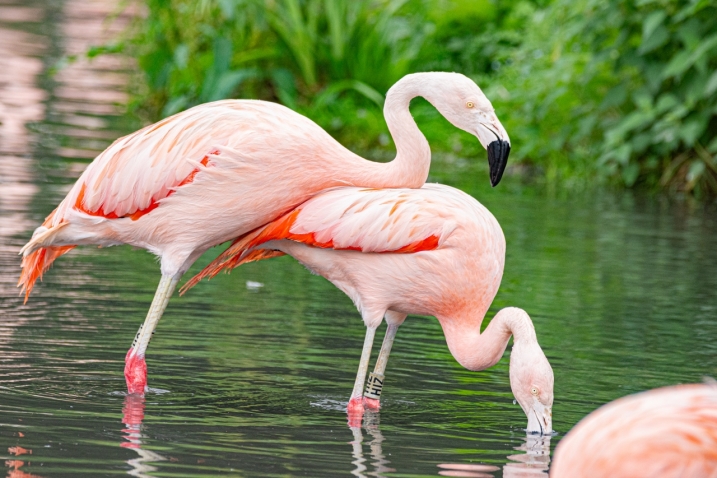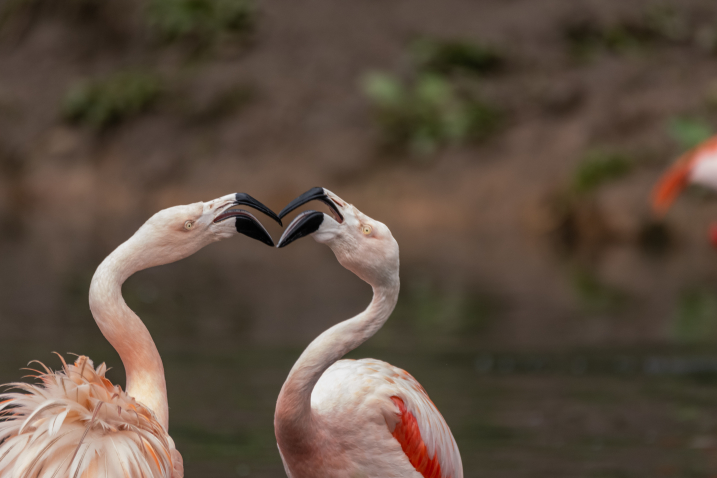Baby flamingos- why the long wait?!
Congratulations to the animal keepers and to the flamingos at WWT Washington on the successful hatching of a Chilean flamingo chick for the first time in four years. But why the long wait...? It's all explained by flamingo ecology.
A very special Flamingo Diary for the end of summer, celebrating the exciting events at WWT Washington this week- the hatching of a flamingo chick in the Centre’s Chilean flamingo flock for the first time in four years. It’s great to see this new arrival and it’s a real achievement for the animal care staff at Washington- their patience and dedication to the birds. So why the four year gap? Flamingos have an unusual breeding cycle, so I thought in this Flamingo Diary entry I would try and explain a little of the bird’s biology and why the Washington flamingo keepers have had to wait for a new arrival.

Spot the new arrival! The chick at just a day or so old, cared for by a protective parent. Photo credit: I. Henderson / WWT Washington.
What do wild flamingos do?
Like all flamingo species, Chilean flamingos are in tune with environmental conditions and this means they will only breed when these conditions are to their liking. Flamingos, more so than many other species of bird, have to time breeding perfectly if they are to raise a chick to fledging (being able to look after itself).
The places that flamingos will choose to nest in are limited. To maximise the chances of producing lots of healthy chicks, birds need to time it just right to nest when the environment is at its best in these specific locations. This means that each flamingo in the flock has to feel like all of the other birds around them are ready breed too. Because it takes a long time to raise a chick, with a lot of investment and energy from both parents, flamingos breed together when everything is perfect to not waste energy and to ensure their chick has the best chance of fledging, and one day producing a chick of its own.
In the birds that we keep at WWT, and for those in other animal collections too, these environmental and flock effects on when is right to nest still apply. Birds won’t breed unless everyone is ready, and the nesting conditions are right for them.
Is it because of their dancing?
Yes! This does indeed have a role in successful nesting events. The complicated and extravagant courtship display of the flamingo has evolved to help out with the decision of when to breed. The more birds that join in with courtship then the more birds are in the right condition for nesting. Lots of courtship dancing means that when conditions are right for nesting, everybody is ready at the same time and in the same place.
It’s good to see courtship display in our WWT flocks because this means that the environment we have provided for the birds is good enough for them to think about nesting.

Lots of courtship means lots of opportunities for pair bonds to form. If everyone pairs up at the same time, nesting occurs all at the same time. This is the flamingo's way of ensuring as many chicks survive as possible. Photo credit: I. Henderson / WWT Washington.
Does this now mean that they will breed every year?
Not necessarily. Flamingos can go for many years between breeding events. For example, a flock of lesser flamingos that lives in southern African will breed successfully once every seven to nine years (on average). And we had a great example of the Andean flamingos at WWT Slimbridge laying eggs in 2018 because the really hot summer encouraged them to breed for the first time in a long time. This might just be the perfect year at WWT Washington for a new flamingo to hatch, and so their keepers will look and see what has happened (Is it weather and the local climate? Diet? Bird husbandry? Enclosure changes?) this year that might have been extra encouraging for nesting.
So this long gap between chicks doesn’t mean the birds are unhappy?
Exactly. Flamingos live for a long time. One of my favourite facts about them is that they can live into their eighties (in human care). The oldest birds at WWT Washington are getting near their 40th birthdays, some of the birds at WWT Slimbridge are well over 60. Flamingos live a long time precisely because they don't breed regularly.
Imagine you are a Chilean flamingo in a flock of a 1000 birds in the wetlands of the Andes Mountains. That means, potentially, 500 breeding pairs that could produce 500 chicks. You do not need to nest every year to ensure your population remains healthy because you can all produce a lot of young in those really good years, and you can afford to wait for the next really good year to come along before you breed again. As a wild flamingo can live into its early fifties, you have plenty of time to replace yourself.

All flamingos need to do the same thing at the same time for successful breeding to occur. Fighting flamingos are not flirty flamingos! Photo credit: I. Henderson / WWT Washington.
Is this chick important for conservation?
YES! Chilean flamingos are a near threatened species in the wild. And sadly they have a declining wild population size. You can find out more about why and what’s being done to protect them on the IUCN Red List website. Even though I said above that flamingos will produce lots of chicks all at the same time, as humans alter the climate and change their habitats birds have to wait longer and longer to breed. So we need to keep these flocks in our wetland centres to make sure flamingos have a secure future in some part of the world.
Birds that are bred in captivity are important insurance populations should things in the wild get really bad. Captive breeding also has the conservation aim of preventing birds from being taken from the wild; by keeping populations in human care sustainable, we can make sure that zoological collections have enough birds to carry on breeding and keep gene pools healthy. Therefore, our birds at WWT play a vital role in the future existence of the Chilean flamingo, and all new chicks are welcome.
If you’re visiting Tyne and Wear, be sure to pop in to WWT Washington and see the new arrival. It’s great for the flock to have a chick as it will bring out so many behaviours that visitors might not have seen before. Despite of all what I have just said about timing and waiting and patience, let’s all keep our fingers crossed for more fluffy grey bundles next year and beyond!
For more information on this flamingo excitement, see this link: WWT Washington flamingo hatching



